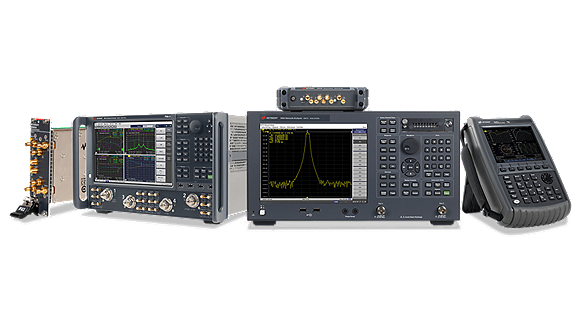Products and Services
Network Analyzers
Gain deeper confidence on the bench, in the rack, and in the field

Products and Services
Gain deeper confidence on the bench, in the rack, and in the field


Whether you are testing active or passive components, the right mix of speed and performance gives you an edge. In research and development (R&D), Keysight vector network analyzers (VNA analyzers) provide a level of measurement integrity that helps you transform deeper understanding into better designs. On the production line, our cost-effective vector network analyzers provide the throughput and repeatability you need to transform parts into competitive components. Every Keysight vector network analyzer is the ultimate expression of our expertise in linear and nonlinear device characterization. On the bench, in a rack or in the field, we can help you gain deeper confidence with Keysight.
Explore the broadest portfolio of network analyzers on the market to find the performance you need.
Discover the fundamental principles behind phased array antenna design and testing, including measurement techniques and calibration. Learn how the Keysight phased array test solution integrates and synchronizes digital control of the PNA-X vector network analyzer, VXG-C vector signal generator, and a compact antenna test range (CATR) to deliver fast, fully automated measurements.
Technology is constantly changing. So too are the requirements engineers face. Get more functionality out of your existing hardware today by pairing it with the right accessories to improve productivity and the right Keysight PathWave design and test automation software to accelerate your product development.
Component amplitude and phase behavior determines the electrical system’s overall performance, including signal sensitivity and distortion. Discover the fundamental principles of vector network analysis in this application note. Learn about vector network analysis terminology and the common network parameters measured, including scattering parameters (S-parameters). Delve into RF fundamentals such as transmission lines, the Smith chart, and power transfer conditions, as well as network characterization.

In this application note, the fundamental principles of vector network analysis will be reviewed. The discussion includes the common parameters that can be measured, including the concept of scattering parameters (S-parameters). RF fundamentals such as transmission lines and the Smith chart will also be reviewed.
Reduce budget challenges with KeysightAccess subscription service.
Vector network analyzers (VNAs) are test instruments that measure electrical network parameters. They are essential for radio frequency (RF) and microwave component analysis of various passive and active devices, including filters, antennas, and power amplifiers.
Network analyzers are the go-to instrument to conduct transmission, reflection, impedance measurements, as well as S-parameter measurements during design and production processes.
For more information, check out: What is a Network Analyzer?
A “VNA analyzer” is a common misnomer for a vector network analyzer, or VNA. So, the term “VNA analyzer” actually means, “vector network analyzer analyzer”, which is redundant.
Vector network analyzers are also correctly referred to as “network analyzers.” However, VNAs should not be confused with networking testers, which are a different kind of test instrument used to measure Internet or mobile network speeds.
For more information about network analyzers, check out: What is a Network Analyzer?
A network analyzer conducts component characterization tests. Network analyzers provide calibrated stimulus signals to the RF network or device under test (DUT) and measure the vector response over the frequency with phase and amplitude information. A VNA captures transmission (transmission coefficient, insertion loss, gain), reflection (reflection coefficient, VSWR, return loss), and impedance measurements, as well as the S-parameters S11, S12, S21, S22.
A VNA measures a variety of devices and networks with numerous measurements for many different use cases like spectrum analysis, pulse measurements, and active device tests. The following guide describes how to set up network analyzer measurements, calibrate your measurement setup, and interpret results: Making Measurements with a Vector Network Analyzer.
Network analyzers include both signal sources and receivers. The receivers detect changes to the output signal from a device (or network) and compare that to the source signal input. A VNA measures both the amplitude and phase responses to assess the device’s effect on current and voltage. The resulting transmission and reflection measurements, impedance, and S-parameters enable test engineers to characterize their DUT.
There are three categories of network analyzers:
VNAs, the most common network analyzer on the market today, offer several benefits to test engineers, including simultaneously measuring all four S-parameters and supporting a wide range of frequencies.
A scalar network analyzer only measures the amplitude properties of the circuit, so no phase information gets captured.
Nonlinear network analyzers are less common than VNAs and SNAs, but they offer the advantage of measuring nonlinear circuits. While NVNAs are extremely accurate, they also pose significant operation complexity, often requiring specialized training to use.
Network analyzers come in handheld, benchtop, and modular form factors, including 2-port, 4-port, and 8-port options. Keysight offers five different types of vector network analyzer families ranging from high-end to compact:
Selection criteria for a VNA varies based on the application or use case of interest. Typical selection criteria include frequency range, number of required ports from 2 up to 24 (multiport) or even 48 in a switch matrix, output power, and instrument class from economy to handheld to high-end.
We recommend you consider these seven main network analyzer aspects before purchasing:
For more information, check out: Key Vector Network Analyzer Specifications
A vector network analyzer measures a variety of devices and networks with numerous measurements for many different use-cases like spectrum analysis, pulse measurements, power amplifier (PA) characterization, and active device tests. The following guide describes how to set up network analyzer measurements, calibrate your measurement setup, and interpret results: Making Measurements with a Vector Network Analyzer.